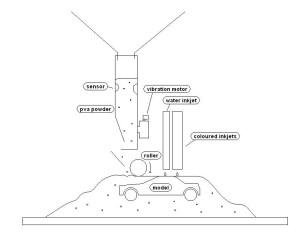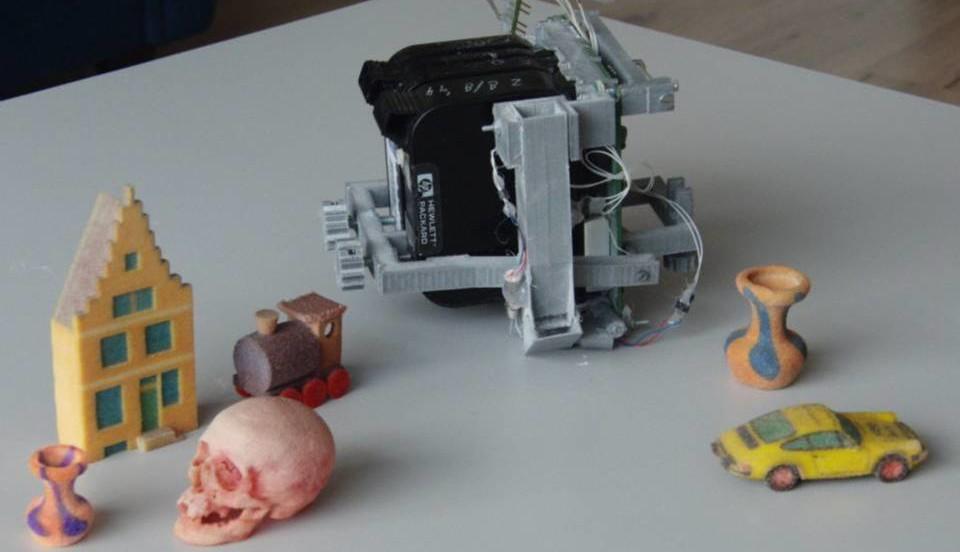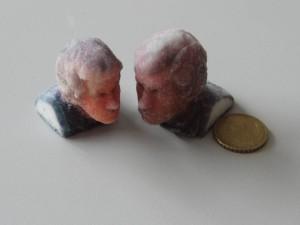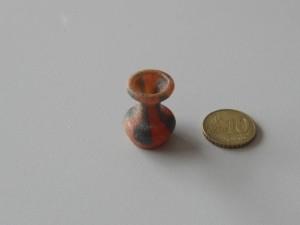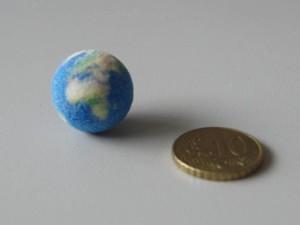While there have been a few custom builds and hacked together machines, most powder bed 3D printers are generally considered commercial or industrial printers. Cost is probably the largest contributing factor to this considering they often cost the same amount of money as a car. The technology itself is simply hard to fit in a desktop device, and there are not a lot of open source options available to easily make one. But when it comes to the 3D printing community I’ve found that where there is a will there is a way, and the developers of the ColorPod are perfect examples of their creativity.
The ColorPod is an almost entirely 3D printable attachment for several RepRap Cartesian style 3D printer variants that allow for the 3D printing of full-color objects using powder materials and a color inkjet printer cartridge. The technology was actually developed in the 1990s by Aad van der Geest as an alternative to the new at the time, and quite costly, advancements with stereolithography 3D printing process. Over the years it has evolved and van der Geest has dramatically improved how the process works and developed some custom software to run it. He’s finally brought together all of the elements and created the ColorPod.
The ColorPod requires a simple attachment to a standard desktop 3D printer, and the device does the rest. It begins just like any powder bed process, by laying down a thin layer of powder material, which is leveled using a spinning roller. Then an inkjet attachment and a water attachment will be used to print the first layer onto the powder, the printer lowers the platform slightly and the process starts over again until the entire model is printed into the powder material. Then it simply needs to be fished out of the pile of powder and hardened with some super glue or hairspray, which also brings out the color.
One of the cooler aspects of the ColorPod is the fact that it is only an add-on to a FDM 3D printer, not an actual modification. The FDM printing head on the printer will continue to be functional, and usable even with the ColorPod attached, which can be surprisingly useful during the printing process. For smaller prints, the powder only needs to be placed down in a pile, and because of the nature of powders it should remain relatively contained enough to support the model. However for larger or taller models the FDM portion of the desktop 3D printer can be employed to print support walls around the powder so it will stay level during the printing process.
Here is some video of the ColorPod attachment being added to an Ultimaker 3D Printer:
Most of the ColorPod parts are actually completely 3D printable; only a few components like a circuit board and a couple of stepper motors need to be sourced. And the device uses a standard HP color ink cartridge to lay down the color and bind the model together, so there is virtually no complex customization work that needs to be done to the printer it is attached to. It can be used with a variety of powder materials, including wallpaper paste, plaster, dry paint powder, polyvinyl alcohol and even sugar.
The custom-designed PC software was developed to make the entire process as easy to use as a typical 3D print job. It is capable of printing both OBJ and full-color STL files, which can be sized and rotated as needed. It even includes a full list of printing configuration options and slicing previews so any complex models can be optimized for printing. Combined with a model made from a 3D scan, the ColorPod can even make full-color, 3D printed selfies.
- Now kiss.
- Tiny vase is tiny.
- Small world.
The technology is still being developed, and van der Geest has an entire list of future adaptations to the basic technology that will expand the available uses. He is working on a process that allows the ColorPod to lay down powder material to be used as support for FDM models that have complex structures and severe overhangs. He is working to develop a process that will allow the inkjet attachment to color FDM prints while they are printing. Additionally, he is working to create a selective laser sintering version that will melt plastic powder materials together with a laser.
The only snags that may trip up some users is the fact that the ColorPod requires two direct USB connections to a computer, one from the printer and the second from the ColorPod device itself. Additionally, I can’t imagine that the powder materials are going to be easy to keep from getting all over the 3D printer itself possibly gumming up the works. But the ColorPod is still in development, and in fact van der Geest is looking for testers in the Netherlands, as well as interested parties to develop powder materials for use with it.
Currently, van der Geest expects to release the ColorPod for sale by the end of the year for about $350. You can find out more information about the ColorPod here. And you can learn more about becoming an early tester by contacting van der Geest here.
Here is some more video of the ColorPod in action. Is this something that you would find helpful in 3D printing? Discuss in the ColorPod 3D Printer Converter forum over at 3DPB.com.
Subscribe to Our Email Newsletter
Stay up-to-date on all the latest news from the 3D printing industry and receive information and offers from third party vendors.
You May Also Like
Gorilla Sports GE’s First 3D Printed Titanium Cast
How do you help a gorilla with a broken arm? Sounds like the start of a bad joke a zookeeper might tell, but it’s an actual dilemma recently faced by...
Nylon 3D Printed Parts Made More Functional with Coatings & Colors
Parts 3D printed from polyamide (PA, Nylon) 12 using powder bed fusion (PBF) are a mainstay in the additive manufacturing (AM) industry. While post-finishing processes have improved the porosity of...
$25M to Back Sintavia’s Largest Expansion of Metal 3D Printing Capacity Since 2019
Sintavia, the digital manufacturing company specializing in mission-critical parts for strategic sectors, announced a $25 million investment to increase its production capacity, the largest expansion to its operations since 2019....
Velo3D Initiates Public Offering in a Bid to Strengthen Financial Foundations and Drive Future Growth
Velo3D (NYSE: VLD) has been among a number of publicly traded 3D printing firms that have attempted to weather the current macroeconomic climate. After posting a challenging financial report for 2023,...



